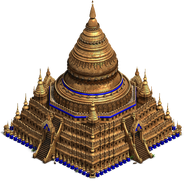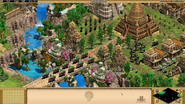| “ | East of the Indian subcontinent, a vibrant and learned culture flourished in the jungles and river valleys. Ascend to power, quash a treacherous rebellion, and restore the Burmese monarchy to its former glory. Assemble the largest empire in the history of Southeast Asia with a legion of Battle Elephants that can demolish the most powerful of defenses. The Burmese unique unit is the Arambai, a ranged cavalry unit with a deadly but inaccurate attack. | ” |
| —Description | ||
The Burmese civilization theme
The Burmese are a Southeast Asian civilization in Age of Empires II HD: Rise of the Rajas. They focus on Monks and elephants.
The Burmese are based on the Pagan Empire and the later Toungoo Empire, the latter of which are the largest empire in Southeastern Asia. The region around Burma is well known for their wide mountain ranges with lush valleys and a vast amount of forests. To reflect on this, the Burmese get free upgrades at the Lumber Camp. Buddhism played a huge role for the Burmese, teaching the importance of humbleness and not valuing any wealth or luxuries. This is highlighted with their cheaper Monastery technologies as well as their team bonus that reveals the location of Relics on the map.
The Burmese army were feared horsemen in the region that were able to hold their own against the Mongol invasion for a while despite their eventual defeat. In particular, the 18th-century Burmese cavalry included the deadly foreign dart-throwers, who are reflected with their unique unit, the Arambai, and one of their unique technologies, Manipur Cavalry.
The Burmese were also known for their use of heavily armored elephants, which is reflected with their other unique technology, Howdah, giving Battle Elephants extra melee armor and pierce armor. Finally, the Burmese foot soldiers were trained martial artists skilled in martial arts such as the Aka and Bando, which is reflected with their infantry getting extra attack with every Age advancement.
Overview
Standing out for the Burmese are their excellent cavalry, most notably Battle Elephants, their strong infantry, and their great Monks. On the downside, their archers are close to being unusable without key upgrades like Thumb Ring, Arbalester, and Leather Archer Armor. The latter is especially unfortunate as their otherwise strong unique unit, the Arambai, direly misses it. However, it remains a very strong unit and is one of the Burmese's selling points. Their navy and siege weapons are average with a few missing upgrades that do not too much harm overall. The defensive structures are also rather average, but their economy is strong.
Campaign appearances
The Burmese have a campaign devoted to their civilization: Bayinnaung.
Characteristics
Unique unit
 Arambai: Cavalry with powerful ranged attack
Arambai: Cavalry with powerful ranged attack
Unique technologies
 Howdah: Gives Battle Elephants +1/+1 armor.
Howdah: Gives Battle Elephants +1/+1 armor. Manipur Cavalry: Gives cavalry and Arambai +3 attack against buildings and standard buildings.
Manipur Cavalry: Gives cavalry and Arambai +3 attack against buildings and standard buildings.
Civilization bonuses
- Lumber Camp technologies are free.
- Infantry has +1/+2/+3 attack in the Feudal/Castle/Imperial Age.
- Monastery technologies are 50% cheaper.
Team bonus
- Relics are visible on the map from the game start.
Changelog
Rise of the Rajas
- Initially, Howdah costs 200f/300w and gives Battle Elephants +1/+2 armor. With patch 5.7, Howdah now costs 400f/300w and gives Battle Elephants +1/+1 armor.
- Arambai initially cost 50 wood and 60 gold. With patch 5.8, they now cost 80 wood and 60 gold.
- (Elite) Arambai initially have 18 (20) attack, 1.35 speed, and +2 cavalry archer armor. With patch 5.7, (Elite) Arambai have 17 (19) attack, 1.3 speed, and no bonus armor against anti-cavalry archer attacks.
- Initially, Manipur Cavalry gives +6 attack against buildings. With patch 5.3, the bonus is spread over the two building classes (building and standard building) equally so Architecture does not cancel the effect completely anymore.
Definitive Edition
- Fixed the issue where the Burmese Relic bonus would permanently reveal spots on the map.
In-game dialogue language
Burmese units speak their namesake, a Sino-Tibetan language (related to the languages spoken by the Chinese and other Sino-Tibetan-speaking peoples) written with a script descended from Brahmic, either Kadamba or Pallava.
Villager
- Hou'ke ဟုတ်ကဲ့ – Yes
- Swa do mè သွားတော့မယ် – I'm going
- Musoe မုဆိုး – Hunter
- Laysama လယ်သမား – Farmer
Monk
- Hou'ke ည့်တော် – Yes
- Chechim badè! ပါတယ်
Military
- Hou'ke ဟုတ်ကဲ့ – Yes
AI player names
When playing a random map game against the computer, the player may encounter any of the following Burmese AI characters:
- Anawrahta (အနော်ရထာ): The founder of the Pagan Empire. Considered the father of the Burmese nation, Anawrahta turned a small principality in the dry zone of Upper Burma into the first Burmese Empire that formed the basis of modern-day Burma.
- Bayinnaung (ဘုရင့်နောင်): Bayinnaung Kyawhtin Nawrahta was king of the Toungoo Dynasty of Burma from 1550 to 1581. During his 31-year reign, which has been called the "greatest explosion of human energy ever seen in Burma," Bayinnaung assembled the largest empire in the history of Southeast Asia, which included much of modern-day Burma, Chinese Shan states, Lan Na, Lan Xang, Manipur, and Siam.
- Binnya Dala (ဗညားဒလ): A court title used at the courts of the Hanthawaddy Kingdom, Toungoo Dynasty and Restored Hanthawaddy Kingdom. Possibly refers to General of Hanthawaddy defeated in the Battle of Naungyo in 1538 or Chief Minister and general of Toungoo (1559–1573).
- Kyansittha (ကျန်စစ်သား): King of Pagan dynasty of Burma from 1084 to 1112/13, and is considered one of the greatest Burmese monarchs.
- Min Bin (မင်းပင်): King of Arakan from 1531 to 1554, "whose reign witnessed the country's emergence as a major power". Aided by Portuguese mercenaries and their firearms, his powerful navy and army pushed the boundaries of the kingdom deep into Bengal, where coins bearing his name and styling him sultan were struck, and even interfered in the affairs of mainland Burma.
- Mingyi Nyo (မင်းကြီးညို): The founder of Toungoo dynasty of Burma. Under his 45-year leadership (1485–1530), Toungoo (Taungoo), grew from a remote backwater vassal state of Ava Kingdom to a small but stable independent kingdom.
- Minkhaung (ပထမ မင်းခေါင်): A Burmese royal title, and may refer to monarchs (kings Minkhaung I/Minkhaung II/Minkhaung of Mrauk-U/Minkhaung of Prome) or viceroys of Toungoo (Minkhaung I of Toungoo/Minkhaung II of Toungoo) in late AoE II era.
- Nanda (နန္ဒဘုရင်): King of Toungoo Dynasty of Burma from 1581 to 1599. He presided over the collapse of Toungoo Empire, the largest empire in the history of Southeast Asia.
- Narapati (နရပတိ): A Burmese royal title, and may refer to: Narapati I of Ava, King of Ava, r. 1442–68; Narapati II of Ava, King of Ava, r. 1501–27; Narapati of Prome, King of Prome, r. 1532–39; Narapati III of Ava, King of Ava, r. 1545–51; and Narapati IV of Ava, King of Ava, r. 1551–55; in AoE II era.
- Sithu (စည်သူ): A Burmese royal title used in the days of Burmese monarchy and may refer to Sithu I/Sithu II/Sithu III/Sithu IV, kings of Pagan, Sithu of Pinya and Sithu Kyawhtin.
- Swasawke (စွာစော်ကဲ): King of Ava from 1367 to 1400. He reestablished central authority in Upper Burma for the first time since the fall of the Pagan Empire in the 1280s. He essentially founded the Ava Kingdom that would dominate Upper Burma for the next two centuries.
- Tabinshwehti (တပင်ရွှေထီး): Tabinshwehti was king of Toungoo Dynasty of Burma from 1530 to 1550, and the founder of Toungoo Empire. His military campaigns created the largest kingdom in Burma since the fall of Pagan Empire in 1287.
Trivia
- If a player picks the Burmese civilization, the bottom middle of the navigation bar will show a green peafowl, which is the royal symbol of Burmese kingdoms since the 11th century.
- The Burmese are the only civilization that lack Leather Archer Armor at the Blacksmith.
- While they primarily represent the Pagan Kingdom and the Taungoo/Toungoo dynasty, they also draw influence from modern northeastern India, namely the state of Manipur, reflected in their use of the Arambai and the Manipur Cavalry unique technology. This is slightly ironic, as the Kingdom of Manipur often fought against the Burmese Empire, although also a bit justified: in the 18th century, Manipur horsemen often fought in Burmese armies and constituted important portions of the Burmese cavalry.
- The Burmese civilization icon is based on the coat of arms of the Konbaung dynasty (actually 18th century)
- The civilization name is based on Burmese ဗမာ Bama, colloquial form of the ethnic name မြန်မာ Mranma, of unknown origin; French linguist Michel Ferlus included this ethonym in the South-East Asia word-family *-ra:ŋ "human being".
History
Since prehistoric times, the fertile plains, navigable rivers, and the protection of surrounding mountains have attracted many ethnic groups to settle in the area of present-day Myanmar (Burma). Between the end of the first millennium BC and the ninth century AD, a multitude of city-states emerged as a result of intensified rice cultivation and growing Indo-Chinese trade. Similar to other early Southeast Asian polities, culture became influenced by the interaction with India. Most of the urban civilizations of Myanmar gradually converted to Buddhism and built many temples. These tall cylindrical temples, called stupas, became the prototype for later religious architecture. For example, the famous 11th century Shwezigon Pagoda was based on this design.
During the Middle Ages, two states succeeded in uniting the different polities of Myanmar into one powerful empire. In 1044, Anawrahta Minsaw (1044-1077) ascended the throne of the small Pagan kingdom in Upper Myanmar. After consolidating the state’s economic power through the building of extensive irrigation networks, Anawrahta conquered most of Upper and Lower Myanmar. Around 1200, the Pagan empire (1044-1297) reached its zenith: the Burmese language became the lingua franca, laws were codified, and the territory reached its largest extent.
The Pagan empire had only a limited standing army in their capital, called the brave ones, but additional troops were conscripted during times of war. The main body of the army consisted of infantry. A number of war elephants, the elite unit of the army and a symbol of power, were allotted to each force. The elephants were often equipped with a Howdah, a sort of carriage, from which multiple archers could shoot. In addition, the Burmese deployed a sizable cavalry force. Soldiers fought with a variety of weapons, including swords, spears, bows, and darts. Despite its many victories in the eleventh and twelfth centuries, the Pagan army was eventually defeated by the Mongols in 1285. Without powerful leadership, the empire soon disintegrated into rivaling states.
By the fourteenth century, four states had filled the void of the Pagan Empire though their rule was highly contested and vassals often rebelled. While these four states waged war among each other, the small kingdom of Toungoo profited by welcoming refugees, expanding its own territory, and raiding neighboring cities. In 1510, King Mingyinyo (1485-1530) declared independence. Under his successors, King Tabinshwehti (1530-1550) and especially King Bayinnaung (1550-1581), Toungoo expanded from a regional kingdom into the largest empire of Southeast Asia, encompassing much of present-day Myanmar, Thailand, and Laos. Extensive use of firearms and the recruitment of Portuguese artillery gave the Burmese a technological advantage in battle.
This explosive growth, however, left the Toungoo Empire ungovernable. Shortly after the death of Bayinnaung, different states rebelled. Instead of consolidating the kingdom’s core region, Bayinnaung’s son, King Nanda (1581-1599), desperately tried to hold on to the large empire. The failure of multiple campaigns against the Thai kingdom of Ayutthaya weakened Toungoo’s military strength. Failed harvests due to climatic cooling weakened the imperial economy. In 1599, Toungoo’s capital was besieged and burned to the ground, marking the end of the second Burmese Empire.






